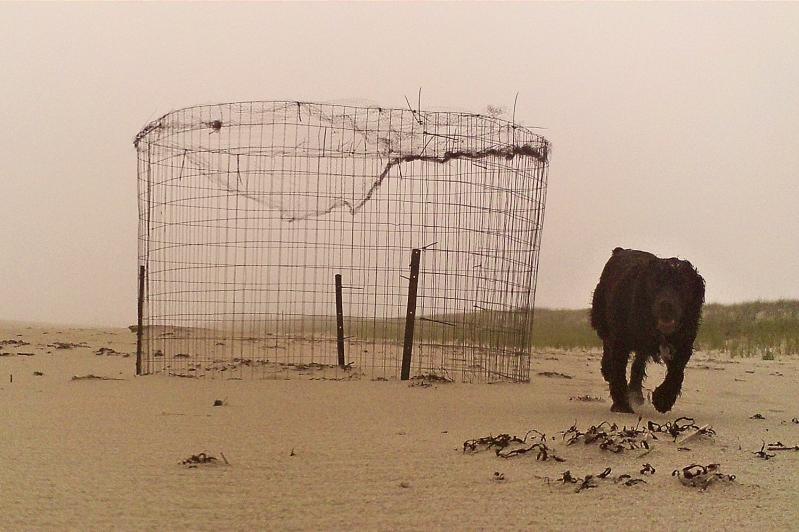It was a bad year to be a piping plover in East Hampton. In fact, the worst since at least 2008.
“It was a difficult year from a productivity standpoint,” said Anna Soccorsi, an environmental analyst with the Town of East Hampton who runs its plover program. The plover productivity rate was only .47. Another way of viewing that number is to say that it took roughly four plovers to produce a single fledged chick, which isn’t enough to support the current population, or grow it further.
According to allaboutbirds.org, there are only 8,400 piping plovers left in the world.
Ms. Soccorsi detailed the successes and failures of the season in the recently released East Hampton Town “endangered species management program end of season report.”
“To be delisted from the endangered species list, the goal for the New York and New Jersey recovery unit is for piping plovers to reach or exceed a productivity rate of 1.5 fledges/pair for five consecutive years and maintain a population level of 575 breeding pairs for five years,” reads the report. The town hasn’t been over the 1.5 productivity level since 2016.
“This year, predation was the primary cause of nest failure, resulting in a loss of 18 nests,” wrote Ms. Soccorsi. While 32 pairs of plovers made East Hampton Town beaches their summer homes, only seven of those pairs were successful in fledging 15 young (10 from bay beaches and five from ocean beaches).
While the news was undoubtedly bad, there were a couple of bright spots. First, Ms. Soccorsi led a team of 15 volunteers, a record, and six motion-activated trail cams, used for the first time ever, were able to identify the cause of chick and egg loss in 40 percent of the nests. Armed with that knowledge, she hopes to develop solutions to the predation problem.
Volunteers submit weekly observations of nests, pairs, and chicks, and monitor sensitive locations through the spring and summer. Together, they tracked 40 nests this season. Only 30 percent of nesting attempts were successful, leading to eggs. A smaller number, 17.5 percent, had successful fledges. (Once a piping plover chick is 35 days old or able to fly 15 meters, it is considered fledged.) After the birds fledge, volunteers remove the symbolic string fencing, used to keep people (and their dogs) away from the nesting areas.
The trail cams proved that predation from foxes, raccoons, crows, and gulls were the major issue. The cameras also showed humans and their dogs continuing to ignore the symbolic string fences. “Off-leash dogs definitely cause disturbance and are a concern. We had images of dogs in stringed-off areas that caused plovers to leave their nests. But the cameras didn’t show dogs leading to nesting loss directly,” Ms. Soccorsi said by phone.
Of the 40 nests, only three were “exclosed” meaning completely fenced in. The exclosures seem to be a mixed blessing. While 100 percent of the exclosed nests led to hatchlings (only 24 percent of un-exclosed nests had hatched chicks) the exclosures are like a giant sign that say “Crow Food.”
“Crows are smart enough to identify a nesting location and exclosures and be in the area when chicks are really defenseless,” she said. She said at Georgica Beach within 12 hours of hatching, all the chicks were taken by crows. The same might have occurred at Napeague, where Ms. Soccorsi observed two hatchlings get gobbled. Knowing there were two eggs left, she sat and waited for them to hatch and then immediately removed the exclosure. Her efforts led to two successful fledges.
“The chicks moved a half mile down the beach with their dad,” she said, indicating that the male bird was aware of the danger posed by the crows hanging out at the hatch location.
Southampton Town had a more successful summer with a 1.43-percent productivity rate (only two chicks away from making 1.5 percent). James Duryea, who runs the program, said crows are a tough enemy and could be tied to the number of people who visit a beach, because they’re scavengers, attracted to food scraps and other pieces of litter. So, keeping beaches clean could be an important component of plover success.
Which beaches are most popular with plovers? On the bay side, Sammys Beach on Gardiner’s Bay attracted seven pairs of plovers and Two Mile Hollow Beach attracted the same number on the ocean. Ms. Soccorsi’s report notes that homeowners near Two Mile Hollow “request increased access and reduced fencing.” Unfortunately, despite the seven pairs, zero chicks were fledged from the location, as “the site suffered from frequent avian and mammalian predation.” Next year, she plans on using exclosures there.
“The New York State Department of Environmental Conservation is communicating with the East Hampton Town’s endangered species management program and piping plover stewards on this issue, particularly what is driving the reduction of successful fledglings,” said a spokesperson for the D.E.C., adding that the agency “will continue to offer support and assistance to the town’s program as it determines actions to improve fledge rates in the future. Anyone who sees illegal activity is advised to contact D.E.C. law enforcement at 1-844-DEC-ECOS.”
“A lot of people when they hear about our efforts, they’re excited and happy to help. We hope to ramp up education with children and the broader public in 2024,” said Ms. Soccorsi. Additional camera traps will also be deployed.
Those interested in volunteering for the 2024 endangered species management season can email her at [email protected].




